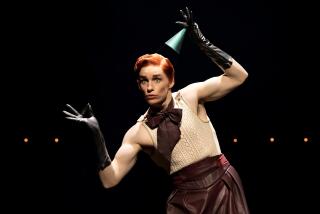Critic’s Pick: Glyndebourne’s ‘Rosenkavalier,’ hit by catty reviews, set for webcast
Alex Ross of the New Yorker has dubbed it Chubbygate.
Last month, several British critics wrote unflattering, sexist remarks about the appearance of Tara Erraught in a new Glyndebourne Festival Opera production of Richard Strauss’ “Der Rosenkavalier.” Now we will all be able to see for ourselves whether the 27-year-old Irish mezzo-soprano looked too plump for the trouser role of a teenager seduced by a ravishing older woman.
The Telegraph newspaper -- whose opera critic, Rupert Christensen called Erraught “dumpy of stature,” one of the more polite phrases -- will host a live webcast of Sunday’s performance from Glyndebourne. The bad news is that the matinee begins at 6:20 a.m. West Coast time, and, since the festival includes long intermissions so its patrons can picnic on expansive lawns, lasts a full five hours.
Most of the angry tut-tutting over the critical response about Erraught’s appearance has been a dismay over its cruelness. But at least some of that dismay may be misplaced. Given the consensus of opinion, Erraught was most likely unconvincing theatrically, in at least a conventional way.
So why was she made to look unflattering and why did the critics say what they did? Erraught is perhaps no slender tomboy, but she is no plumper than the irresistibly enchanting Christa Ludwig in the famous film of the opera conducted by Herbert von Karajan.
But as an emerging singer, Erraught was forced to be putty in the hands of a powerful director. That director is Richard Jones, one of the Britain’s most celebrated and occasionally controversial. Erraught should have had plenty to worry about given that Jones directed the Royal Opera production of Mark-Anthony Turnage’s “Anna Nicole,” in which he got away with murder by disguising offensive sexism with anti-Americanism.
The argument that opera when staged is only about the voice is nonsense. A director’s -- and a singer’s -- responsibility is to create a stage illusion, one way or another. Singing is a physical activity and a watched singer will make a visual as well as an aural one. The two cannot be separated as much as some would like them to be.
A great director, moreover, will find a way. Early in her career, Jessye Norman was thought too large for the lyric stage until avant-garde director Robert Wilson began working with her. He taught her how to move, how to use her every ounce to create a magnificently commanding presence. She became an operatic goddess.
When faced with directing the impossibly squat but vocally exquisite Montserrat Caballé in Strauss’ “Salome” at La Scala, Wilson came up with another brilliant solution. He simply moved the acclaimed Spanish soprano off stage and used dancers as Salomes.
On the other hand, I once saw the great Birgit Nilsson as Salome with the Vienna State Opera. Her singing had a penetrating intensity that seemed to shoot straight through the audience. I’ll never forget that. But unfortunately I’ll never also forget just how silly she looked attempting the “Dance of the Seven Veils.”
And what about those catty British critics? That’s the London newspaper style. After all the Fleet Street revelations of the past couple years, can you possibly be shocked? Then again, we can thank one of those Fleet Street institutions for sponsoring the webcast on Sunday.
More to Read
The biggest entertainment stories
Get our big stories about Hollywood, film, television, music, arts, culture and more right in your inbox as soon as they publish.
You may occasionally receive promotional content from the Los Angeles Times.







